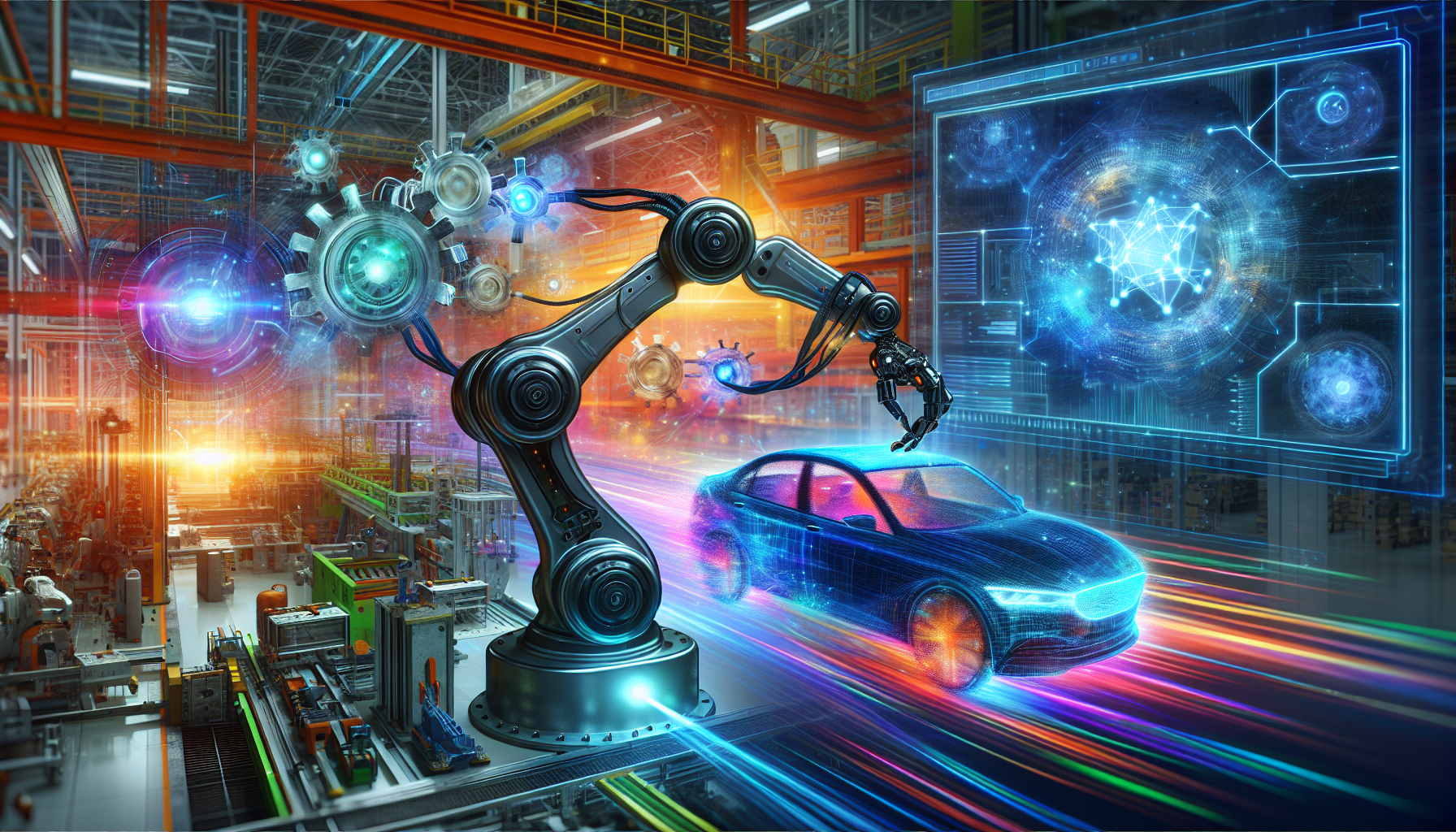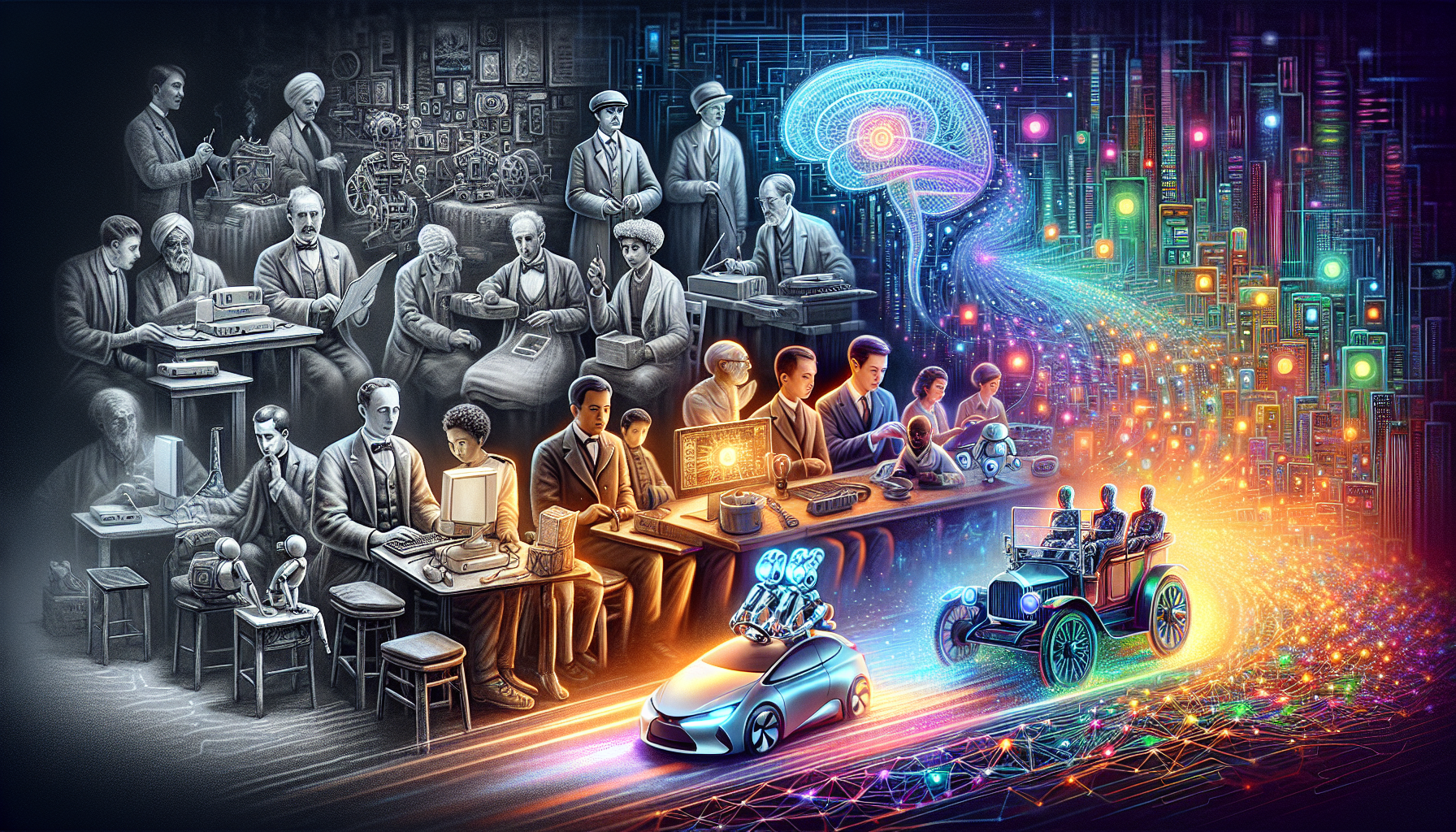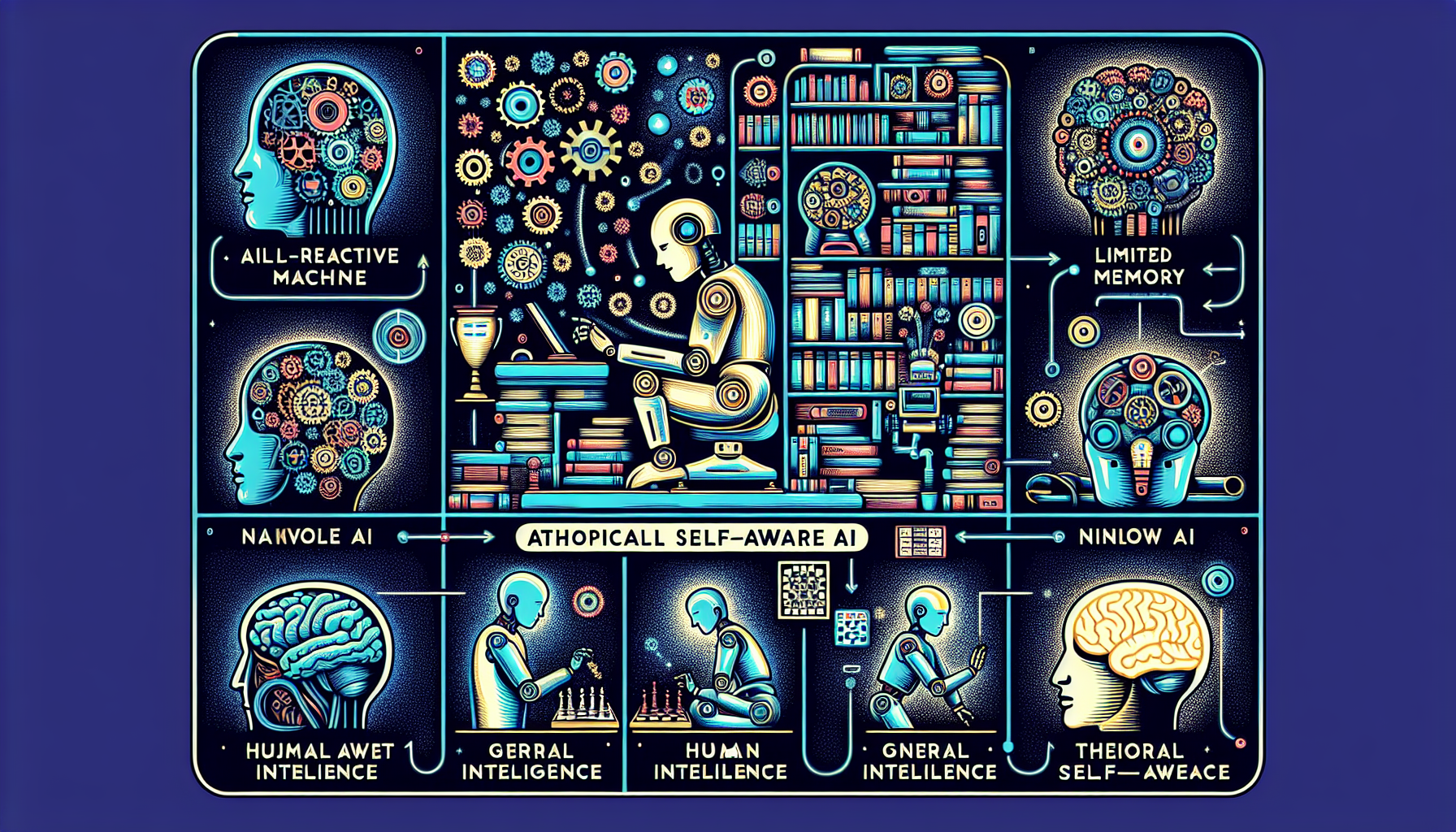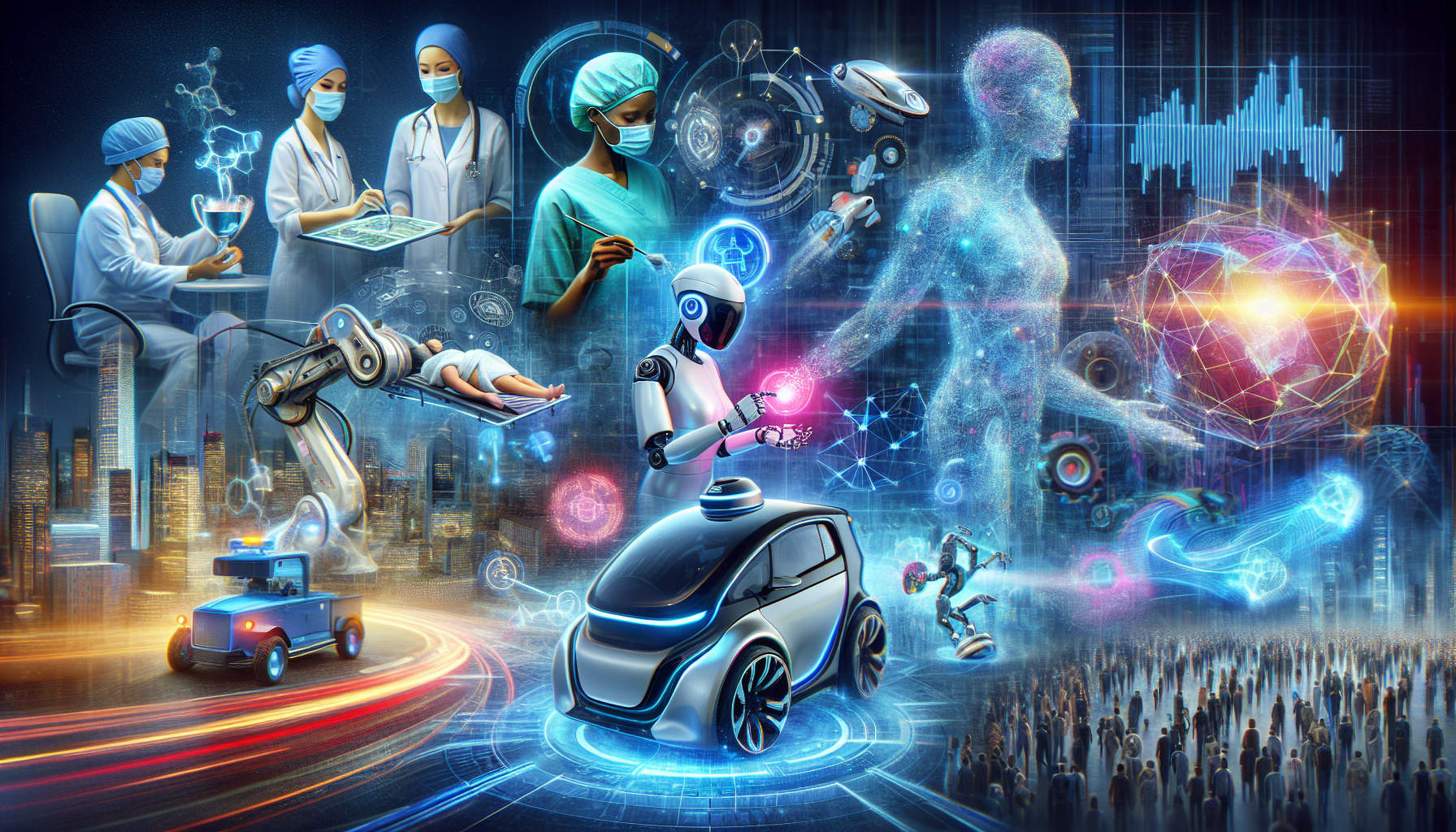This piece will delve into artificial intelligence (AI), a technology that allows machines to mimic human intellect, which has become integral in our everyday activities through advancements such as facial identification and self-driving vehicles. AI uses predictive analytics to forecast trends and outcomes, enhancing its ability to make informed decisions. AI can perform tasks like automating routine tasks in journalism and analyzing large data sets to find trends. It discusses AI’s definition, its operational mechanism via machine learning and neural networks, and examines its substantial applications along with the economic promise it holds across different sectors.
Key Takeaways
AI is driving innovation across many industries, with significant potential to impact the global economy by 2035.
AI has evolved through significant periods of progress and setbacks, with modern achievements like deep learning and natural language processing transforming various sectors.
AI’s applications range from healthcare and finance to transportation and entertainment, while ethical considerations and robust governance are critical for its responsible development.
Algorithmic bias is a critical ethical consideration in AI development.
Introduction

Have you ever wondered how machines can learn to recognize faces, translate languages, or even create art? The answer lies in the complex and fascinating field of Artificial Intelligence (AI). As the simulation of human intelligence in machines, AI is the engine driving innovation and efficiency across a multitude of industries. It’s a world where neural networks, natural language processing, and reinforcement learning are not just buzzwords but tools that impact our daily lives.
The promise of AI is not just in the cool gadgets and convenience it brings, but also in its economic potential. By 2035, AI could contribute a staggering $15.7 trillion to the global economy, with powerhouses like China and the United States poised to reap the most benefits. As we peel back the layers of AI, we’ll discover how it’s not only about what it can do for us today, but also about the foundations it’s laying for a smarter, more connected tomorrow.
The Evolution of Artificial Intelligence

Embark on a voyage to the origins of AI, where we trace the roots of machine intelligence.
As this progression unfolds, narratives once relegated to science fiction become established realities. In this new era, artificial intelligence revolutionizes industries and revamps how choices are made—casting potentially profound effects on the worldwide economic landscape. Thus our journey is more than a historical reflection. It’s a tribute to AI’s capacity for radical transformation. Symbolic AI played a crucial role in early AI research, focusing on human-readable symbols and rules, but faced significant challenges such as scalability and handling ambiguous information.
Examining pivotal moments and obstacles within AI’s development reveals a persistent saga of ingenuity that sculpts our yesterdays, todays, and tomorrows.
Early AI Research
The roots of AI intertwine significantly with philosophical inquiries, influenced heavily by intellectual titans such as Aristotle and Descartes. Their insights into the representation of knowledge and logical deduction have been foundational for contemporary AI paradigms. The seminal event that catalyzed formal AI research was a workshop at Dartmouth College in 1956, which led to rapid advancements including the development of Lisp—specifically designed for AI—and the implementation of the Turing test to evaluate machine intelligence.
In the midst of the 1960s, Eliza emerged as an initial foray into natural language processing technology, demonstrating early promise in machines’ ability to mimic human conversation. This period brimmed with anticipation regarding future possibilities and laid down a critical framework from which today’s advanced generative models and sophisticated AI tools have evolved.
The path of AI has not always been one of forward momentum. From 1974 to 1980, the domain faced its first significant setback known as the AI winter. This was a time when technology’s limitations and growing disillusionment became apparent, and symbolic AI struggled with challenges in areas such as learning, object recognition, and commonsense reasoning. Despite this period of stagnation, deep learning began to gain traction alongside expert systems during the 1980s, reviving enthusiasm for artificial intelligence.
Another spell of difficulty emerged lasting up until the mid-1930s. It was an era characterized by skepticism towards AI, which led to reductions in funding. Thanks to dedicated AI researchers who pressed on amid these tough times—and coupled with relentless progress in technology—AI managed not just to endure but also set itself on a course for burgeoning success going forward.
Modern AI Milestones
We are living through an epoch defined by monumental strides in AI that have both fascinated us and altered the fabric of our daily lives. IBM’s Deep Blue marked a pivotal chapter in 1997 when it triumphed over a reigning world chess champion, signifying more than just mastery of the game—it was proof positive of AI’s prowess in strategic thought and analysis.
Dominating this decade is generative AI, with tools such as Midjourney and DALL-E forging ahead with text-to-image generators that redefine artistic possibility. Meanwhile, OpenAI unveiled its language model GPT-3 in 2020—a milestone illustrating significant advances made within the realm of comprehending and generating human language. The rise of generative AI tools has further accelerated, automating tasks such as document drafting and summarization, product design and ideation, and computer programming in business settings.
How Artificial Intelligence Works

Delving into the realm of artificial intelligence reveals an intriguing fusion of data, algorithms, and machine learning. Fundamentally, AI endeavors to mimic human cognitive functions through machines which have the ability to interpret input and extrapolate output intelligently. This process involves a harmonious combination of extensive datasets with rapid iterative operations coupled with sophisticated algorithms capable of executing complex tasks more dependably and swiftly than humans.
An essential component of AI is the artificial neural network, which mimics the structure and functioning of the human brain. These networks consist of interconnected nodes or neurons that process information in layers. There are various types of artificial neural networks, including feedforward, recurrent, and convolutional networks. Feedforward networks pass data in one direction from input to output, while recurrent networks have connections that loop back, allowing them to maintain information over time. Convolutional networks are particularly effective for image processing tasks due to their ability to recognize patterns and features in visual data.
Through absorbing vast quantities of labeled training data, AI systems identify correlations and discern patterns within this information. Utilizing these insights enables them to project outcomes for new scenarios they encounter. Essentially, it is a systematic procedure where machinery autonomously learns from characteristics or recurring elements in the provided data. Here machine learning algorithms serve as essential instruments that drive this acquisition of knowledge by AI systems.
Machine Learning
Machine learning acts as the driving force behind AI, allowing computer systems to learn from data, recognize patterns, and make decisions independently. As computational capabilities have soared alongside a deluge of data availability, this branch of artificial intelligence has flourished. It grants machines the capacity not only for performing tasks such as image recognition and translating languages, but also enhances their abilities without human intervention.
A variety of machine learning techniques exist.
Supervised learning involves teaching AI systems using labeled data.
Unsupervised learning works with unlabeled data.
Reinforcement learning rewards certain actions or behaviors.
These methods equip artificial intelligence with the ability to handle our world’s intricate challenges ranging from devising strategies in games to applying robotics in tangible scenarios and making sophisticated decisions.
Neural Networks and Deep Learning
Deep neural networks, influenced by the architecture of the human brain, feature layers similar to neurons with an arrangement that includes an input layer, multiple hidden layers, and an output layer. Deep learning falls under machine intelligence’s broader domain—machine learning—and leverages these intricate neural network structures to intricately assess and manipulate data for a given task using dedicated deep learning algorithms.
The refinement process for these neural networks engages techniques such as backpropagation—which tweaks connection strengths to yield more accurate results—and feedforward architectures that ensure signal flow exclusively in one way through the network. Backpropagation plays a crucial role in refining neural networks by adjusting the weights of connections based on the error rate of the previous epoch. This synthesis of concepts from various disciplines like statistics and physics has significantly advanced deep learning within artificial intelligence (AI), showcasing its broad adaptability and potential across numerous AI-driven applications.
Natural Language Processing
Natural language processing (NLP) acts as an intermediary, bridging human language and computational understanding. This field enables our interactions with machines using the languages we use daily, involving activities such as translating text, recognizing speech, speech recognition, and analyzing emotions. With the integration of deep learning techniques, NLP has significantly advanced its potential to transform our interaction with digital systems.
The progression of AI puts NL on the map.
Types of Artificial Intelligence

AI encompasses a wide array of systems ranging in capability and complexity, from those designed to execute narrowly-defined tasks to the aspiration toward artificial general intelligence. Narrow AI, also known as weak AI, is designed to perform a specific task such as language translation or image recognition, whereas general AI aims to understand, learn, and apply knowledge across a wide range of tasks, similar to human cognition. Today’s most sophisticated AI technologies still fall short of human cognition across various contexts, but they excel at specialized operations which highlight the diversity within this domain.
In their quest, AI researchers are split between two principal objectives: some strive for the ambitious goal of creating artificial general intelligence that could rival or surpass human intellect while others focus on enhancing narrow AI applications aimed at addressing specific challenges. This dual approach epitomizes both the debate and aspirations permeating the community as it looks forward to a future where machines may tackle an extensive range of problems with fluidity comparable to that found in human intelligence.
Narrow AI vs. General AI
Currently, the most common type of artificial intelligence is known as narrow AI. This form specializes in conducting specific tasks with high precision, such as language processing and image recognition. Despite their narrower focus, these systems can achieve exceptionally high accuracy within their specialized fields. General AI, which would endow machines with a human-like ability to perceive, reason and perform a wide array of tasks, remains an unrealized idea.
The journey from the sophisticated yet trained capabilities of today’s narrow AIs towards the overarching goal of general AI outlines the developmental trajectory of machine intelligence. It mirrors our own aspirations to forge technology that not only aids us but might also one day equal our comprehensive understanding and versatility.
Self-Aware and Theory of Mind AI
Exploring the advanced domains of theoretical artificial intelligence introduces us to the notion of self-awareness and theory of mind AI. These sophisticated versions would have a grasp on human emotions and thought processes, providing tailored interactions with an element of empathy. Although these concepts haven’t come to fruition yet, a theory of mind AI has the potential for understanding others’ mental states, while self-aware AI could attain consciousness and a deep realization of its existence.
The burgeoning field known as emotion AI seeks to discern and emulate human emotional responses, but currently lacks this level of sophistication. The emergence of such technologically advanced forms would be groundbreaking in how machines relate to humans, diminishing the distinctions between our own natural intellects and those crafted by human ingenuity.
Applications of AI in Various Industries

AI transcends theoretical concepts and intricate details, asserting its influence through tangible implementations across diverse sectors. It functions as a vital partner in business, providing customized solutions that bolster:
Operational efficiency
The quality of customer service
Strategic development processes
Policymaking involves policymaking.
Leading corporations and various industries are tapping into the power of AI to stay ahead of their competition and transform all aspects of their business practices.
The infusion of AI into everyday corporate activities reaches areas such as client support, lead identification, anomaly detection in transactions, management of product quality, and scrutinization of legal papers. It enhances cybersecurity measures by introducing automation processes, it observes data traffic within networks, guides machinery on manufacturing floors, examines items for defects, constructs virtual models (digital twins); uses analytic tools to track productivity levels. AI’s innovative influence reshapes fields from health services to media & entertainment—innovating operational procedures while fostering novel avenues for artistic expression and engagement.
AI in Healthcare
In the medical field, AI stands as a pillar of progress that not only improves patient health outcomes but also cuts down on healthcare expenses. It has evolved from its rudimentary role in diagnosing through expert systems to its current application where AI-driven software swiftly sifts through CT images to identify signs of stroke. Presently, by examining X-rays and CT scans with remarkable speed and precision, AI is capable of detecting diseases more effectively while machine learning models, honed on vast collections of medical data, aid in delivering swifter and more accurate diagnoses.
The applications for AI go well beyond just diagnostics. It plays a pivotal role by:
Evaluating risks associated with various ailments and tailoring treatment regimens based upon an individual’s clinical history, genetic profile, and lifestyle particulars
Optimizing administrative operations such as managing medical records efficiently or streamlining appointment scheduling while simplifying explanations regarding payment procedures
Leveraging predictive modeling techniques fueled by algorithms to tackle outbreaks on a global scale
AI in Finance
The adoption of AI in the financial industry has been wholehearted, as it is now integral to various services like online retail banking, investment counseling, and insurance mechanisms. Financial institutions are employing AI-driven chatbots that deliver immediate account information and tailored advice for finances. This technology not only elevates efficiency but also offers a degree of personal engagement previously exclusive to direct interactions with human advisors.
AI’s influence on the finance sector extends across numerous aspects such as bespoke management of portfolios, fraud detection, and the identification of fraudulent activities. The ability of AI systems to analyze copious amounts of data allows them to:
Detect actions that may be indicative of fraud
Promptly notify financial entities
Protect assets belonging to clients
Maintain overall fidelity within the complex structures governing finance.
AI in Transportation
AI algorithms are revolutionizing transportation in numerous ways, including:
Self-driving cars that utilize Limited Memory AI to analyze and act upon environmental data in real-time for safer and more efficient driving. Computer vision is used in self-driving cars to analyze and act upon environmental data in real-time.
The use of AI to manage live traffic information gathered from GPS systems and surveillance cameras helps streamline traffic flow, diminish jams, and enhance road safety.
By evaluating current conditions on the streets, weather patterns, and the condition of roads themselves, AI provides drivers with suggestions for the most effective routes.
Route optimization to determine the best possible paths for vehicles, reducing travel time and fuel consumption.
This transformation has profound implications for how we get around. Consequences include not only less time spent traveling, but also a decrease in accidents. Thanks to route optimization made possible by these technologies, there could be reductions in harmful emissions. Transportation infused with AI is at an intersection where improved safety meets greater efficiency while leading towards environmental sustainability – all key factors that may radically alter our concept of travel.
AI in Entertainment
The entertainment industry has been transformed by AI, which now plays a pivotal role in creating personalized content recommendations and enhancing gaming experiences. AI-driven recommendation engines, such as those used by Netflix, analyze user data to predict and suggest relevant content, thereby increasing engagement and satisfaction. Generative AI goes a step further by producing content like essays, problem-solving explanations, and realistic images, all from a user’s prompt, showcasing AI’s creative potential.
In gaming, AI improves the experiences by making non-player characters (NPCs) more responsive and intelligent, and refining game mechanics. The resulting games are more immersive and challenging, offering players a richer and more engaging experience.
The Role of AI in Blockchain Technology
Merging AI and blockchain technology, two significant technological advancements, is creating a new frontier. Here’s how AI is improving the capabilities of blockchain technology.
By predicting which node will complete a block first, AI minimizes unnecessary work and costs while boosting transaction efficiency.
With cutting-edge decentralized learning systems and innovative techniques for sharing data, AI effectively tackles challenges related to the scalability of blockchain.
The optimization of consensus mechanisms through AI lessens energy consumption and quickens the verification process in blockchain networks.
The amalgamation of artificial intelligence with blockchain heralds an era that encompasses enhanced security, elevated efficiency, as well as breakthrough innovation. The predictive prowess inherent in AIs combined with the tamper-proof records maintained by blockchains engenders a powerful synergy geared towards crafting secure, distributed networks poised for intelligent operations.
Enhancing Security
AI enhances the security of blockchain technology through:
Analyzing transactional data to identify patterns indicative of fraud, thus enhancing the integrity of the blockchain network
Enabling blockchain frameworks to adapt and defend against new cybersecurity threats, thereby strengthening their resilience to possible assaults
Converting extensive systems into micro-economic settings that promote a more secure and effective ecosystem for blockchains
The perpetual learning and adaptive nature of AI provide an imposing barrier against fraudulent activities and cyber risks. With the growing adoption of blockchain technologies, AI’s contribution in safeguarding these structures’ security and reliability grows ever more crucial.
Smart Contracts and Automation
Artificial Intelligence is transforming the capabilities of smart contracts, enabling them to:
Represent intricate business dealings
Independently confirm these agreements on the blockchain
Automatically carry out their terms when certain variables change, like price shifts
Enhance both effectiveness and dependability
Adopt automated decision-making processes that take into account external information and historical results
This innovation could drastically simplify numerous aspects of commerce and administration.
Incorporating AI into smart contracts promises a transformative shift toward sophisticated and adaptive contract management. The synergy between these technologies stands to greatly diminish intermediary involvement, slash transactional expenditures, and accelerate commercial activity.
Data Integrity and Fraud Prevention
AI’s predictive analytics are instrumental in fraud detection within blockchain systems, identifying suspicious activities based on data patterns. By overseeing data management tasks, AI ensures data integrity and proper usage tracking within blockchain, safeguarding against manipulation and misuse. Blockchain’s tamper-proof data records complement AI-driven security measures, enhancing the reliability and trustworthiness of the data.
The collaboration between AI and blockchain in safeguarding data integrity and preventing fraud is a testament to the transformative impact of these technologies. Together, they create a fortified infrastructure where data is not only secure but also utilized responsibly and ethically.
Ethical Considerations in AI Development
As AI systems increasingly permeate our lives, ethical considerations become paramount. Fairness in machine learning is a critical area of study to prevent harm caused by algorithmic bias, especially in sensitive fields like medicine and finance. Ensuring fairness and preventing bias involves addressing discrimination based on race, gender, and socioeconomic status. Human-centered design in AI focuses on creating systems that meet user needs and values rather than just technical capabilities.
The field of machine ethics is concerned with:
Imbuing machines with ethical principles
Developing procedures for resolving complex dilemmas
Creating friendly AI machines that minimize risks and benefit humans
As we contemplate AI’s long-term impacts on society and the environment, it becomes essential to consider these unintended consequences and risks to mitigate any negative effects.
Bias and Fairness
Organizations must remain vigilant to the potential for AI to create biased and discriminatory systems. The COMPAS program is a stark example, where racial bias led to differential error rates for different racial groups, underscoring the need for careful evaluation of the data used to train AI systems. Addressing bias, including algorithmic bias, and ensuring fairness is not just a technical challenge, but a societal imperative that requires a concerted effort to eliminate discrimination in AI applications.
Incorporating human-centered design principles into AI development is crucial. This approach prioritizes the creation of systems that are equitable, accessible, and attuned to human needs, thereby fostering an environment where AI serves to enhance, rather than undermine, human dignity and equality.
Transparency and Accountability
The foundation of trust in AI systems is built on the pillars of transparency and accountability. It’s essential that users have a clear understanding of the decision-making process within AI systems, which demands straightforward explanations and insight into their inner workings. Accountability requires assuming responsibility for the actions taken by these systems, including rectifying any adverse effects or mistakes they may produce. Notable efforts emphasizing these key principles include the U.K.’s hosting of the 2023 AI Safety Summit and moves to embed a “right to explanation” in draft versions of EU’s General Data Protection Regulation.
For transparency and accountability within AI to be ensured, certain steps are necessary.
Cultivating trust amongst users
Promoting a sense of duty among developers and all involved parties
Establishing comprehensive governance frameworks tasked with supervising operations related to AI
Aligning closely with ethical guidelines as well as prevailing legal requirements
Ensuring a right to explanation for users
Privacy and Data Protection
In the realm of ethical AI creation, safeguarding privacy and ensuring data protection are paramount. The advancement of machine learning algorithms has given rise to concerns about potential surveillance breaches and copyright issues, prompting a discussion on how to maintain equilibrium between technological progress and personal freedoms.
To uphold ethical standards in AI development, it’s critical that we:
Safeguard user data against exploitation
Enact robust protections for individual’s private information
Allow AI’s positive uses while upholding respect for privacy and human rights.
Artificial intelligence can actually bolster measures aimed at protecting privacy, such as those inherent in blockchain technology with its decentralized structure designed to preserve confidentiality. An instance where AI aids in maintaining discretion without compromising the veracity or safety of information is through zero-knowledge proofs.
AI Governance and Regulation
As AI technologies continue to evolve, the significance of governance and regulation in mitigating risks and addressing moral dilemmas intensifies. Efforts to construct a legislative structure for AI are exemplified by initiatives like the Blueprint for an AI Bill of Rights from the White House Office of Science and Technology Policy, the AI Bill of Rights, as well as the Council of EU’s pursuit towards an encompassing AI Act. Reflecting this commitment, U.S. Vice President Kamala Harris has divulged global pledges focused on implementing restrictions around military applications of artificial intelligence—this aligns with maintaining adherence to established international laws while ensuring transparency throughout development processes.
In parallel, within America’s legal framework, there are regulations such as Equal Credit Opportunity. Act impacts how entities can apply AI technologies relating specifically to fair lending practices—similarly echoed by Europe’s General Data Protection Regulation (GDPR) influence over consumer-facing implementations—and accentuating that regulatory measures need continual updates so they remain effective alongside rapid technological progress.
Global AI Policies
Globally, governments are diligently formulating legislative and policy measures for AI governance to keep pace with the swift advancement of AI technologies. Initiatives such as national strategies and ethical guidelines often lay the groundwork for these regulatory approaches. Nations like Argentina, Australia, China, and the United States are at the forefront of establishing frameworks dedicated to governing AI practices. Meanwhile, international entities including OECD (Organisation for Economic Co-operation and Development), G7 (Group of Seven), UNESCO (United Nations Educational Scientific Cultural Organization), and ISO (International Organization for Standardization) are also in pursuit of creating comprehensive multilateral AI governance structures that strive to harmonize innovation with societal trust.
In this context, NIST’s contributions toward shaping technical standards specific to artificial intelligence stand out. By interacting closely with industry partners, they identify pivotal areas where development is needed in standard-setting activities along with recognizing any shortcomings present within them currently. The development process has led to instruments like the “AI Risk Management Framework” or “AI RMF 1.0”, which champions integration into globally recognized benchmarks pertaining specifically towards risk management within an ai-centric ecosystem – endorsing crucial international standards such as those set forth by ISO/IEC JTC 1/SC 42 on Artificial Intelligence – i.e., ISO/IEC TR 24028:2020 (“Overview Of Trustworthiness In Artificial Intelligence”) & IEC International Electrotechnical Commission’s committee on Governance Implications Of Digital Transformation And Emerging Technologies ISC DITET — e.g., IEC/PAS (“publicly available specification”) published document type defined by IEC allowing urgent standardization requirements be published quickly without having complete consensus normally required formal Standards).
Industry Standards and Best Practices
AI systems require thorough and standard assessments to ensure their safe implementation. The National Institute of Standards and Technology (NIST) is responsible for creating the guidelines and best practices necessary for crafting secure AI systems that are deemed trustworthy. To identify weaknesses in AI systems, red-teaming approaches are utilized. These involve using adversarial techniques aimed at strengthening the security and resilience of such systems. Federal policy promotes an approach to AI development which benefits American workers while steering clear of uses that might infract on rights or diminish job quality.
It’s critical that safety protocols encompass evaluations for possible damage when it comes to artificial intelligence, taking into account issues like threats to cybersecurity as well as biosecurity concerns. Specifically targeting sectors with critical infrastructures implementing AI, NIST’s “AI Risk Management Framework” (referred under its document number NIST AI 100-1) outlines key recommendations directing a holistic strategy toward managing risks associated with artificial intelligence applications.
Future Regulatory Trends
Future regulatory trends in AI, vital in their own right, focus on the technology’s evolving capabilities and societal impacts. As AI technologies progress, new regulatory frameworks become essential to manage their complexities and ensure ethical development. The societal implications of AI, including privacy, employment, and fairness, necessitate enhanced governance and regulation to address these challenges.
Emerging regulatory frameworks are being developed to tackle the challenges posed by advancing AI technologies and their societal impacts. These frameworks will play a crucial role in shaping the future landscape of AI, ensuring that its development is responsible, ethical, and aligned with societal values.
Summary
Reflecting on the sophisticated domain of Artificial Intelligence, we contemplate its substantial influence on our daily lives. The field has transformed from early aspirations to mimic human intelligence into a fundamental cornerstone for progress through machine learning, neural networks, and natural scene processing. AI is pivotal in advancing industries by enhancing decision-making capabilities, streamlining intricate operations, and significantly contributing to economic development worldwide.
Throughout this exploration, the importance of ethics, oversight policies and regulatory frameworks has been underscored to ensure that as AI systems advance their abilities they remain aligned with human values. We must welcome the future that AI promises with judicious enthusiasm—acknowledging both its limitless possibilities and the obligation to employ such potent technology prudently.
Frequently Asked Questions
What is Artificial Intelligence (AI)?
Computer systems equipped with artificial intelligence (AI) are crafted to replicate processes of human intelligence, engaging in behavior typically associated with human thought and action. This emulation encompasses various techniques including machine learning, neural networks, and natural language processing. Such technologies enable these computer systems to execute functions that traditionally necessitate the cognitive abilities unique to humans.
How does AI impact the global economy?
Artificial Intelligence (AI) plays a significant role in the enhancement of the world economy, with projections suggesting it could contribute as much as $15.7 trillion by 2035. Its impact on fostering innovation and improving efficiency is anticipated to propel economic expansion, with nations such as China and the United States standing to gain considerably.
Seize the opportunity presented by AI’s potential advantages for molding the economic landscape of tomorrow!
What are the different types of AI?
AI can be categorized based on its functionality into specialized narrow AI, designed to perform particular tasks, and broad general AI, which aims to mimic human intelligence. The capabilities of AI extend across various types including reactive machines, limited memory AI, theory-of-mind AI, and self-aware AI.
It is essential to select an appropriate type of artificial intelligence according to the specific requirements at hand.
How does AI enhance security in blockchain technology?
By studying transaction data to discern fraudulent patterns and adapting to cyber threats, AI strengthens security within blockchain technology. This enhances the protective measures in expansive systems.
Such an integration turns these systems into micro-economic settings, which serves to elevate their overall level of security.
What are the ethical considerations in AI development?
In the development of AI, it is crucial to tackle issues related to bias and fairness while also maintaining transparency and accountability. Protecting privacy and data is essential. The goal of these ethical considerations is to avert any potential harm, offer lucid explanations for AI decisions, and ensure the security of user information.
Posted in AI, Blockchain





